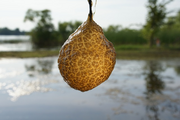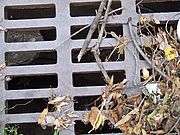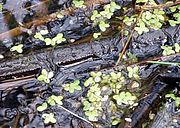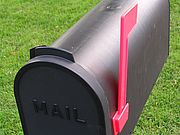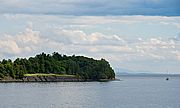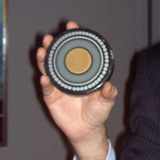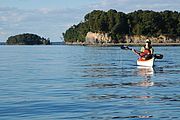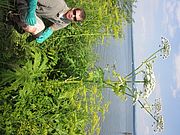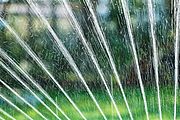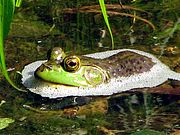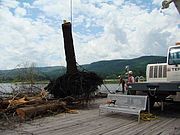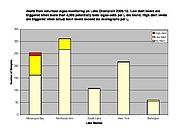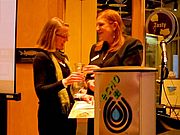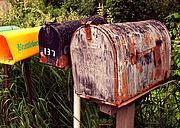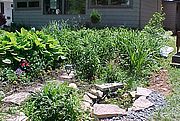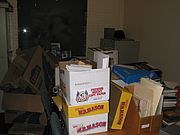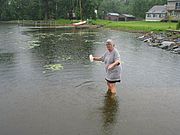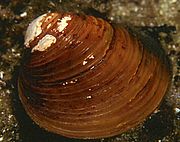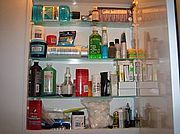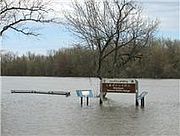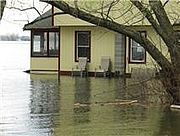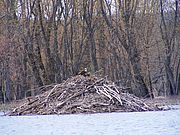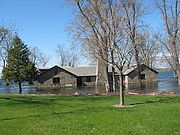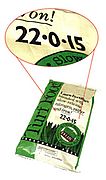Brown jelly-like blobs have been reported from various places around Lake Champlain this summer. The patterning on the surface of the blobs makes them resemble brains or diseased tree branches. These are actually colonies of sessile invertebrate animals called bryozoans. While the blobs may range from golf ball to melon-sized, each individual in the colony is microscopic. Most bryozoan species live in marine environments, but 50 species are known from freshwater including 21 from North America. The species most commonly observed in Lake Champlain is probably Pectinatella magnifica. Bryozoans tend to grow on wood or other vegetation in areas where the water is quiet. They do not tolerate polluted conditions and require fairly high oxygen levels in the water. Occasional summer outbreaks have been recorded on other waterbodies, but it is unclear why they happen. Read...
News from Selected Month
One small step you can take to minimize damage from storms to local roads and waterways including Lake Champlain is to clear any storm drains in your neighborhood. When storm drains clog, the water that they are designed to collect bypasses the drains and erodes at road beds. In addition to weakening the road the eroded soils wash into water bodies adding to the pollution load from storms. Unclog the drains by simply removing any debris on the grate or blocking water’s access to the grate. It’s a small step, but every little bit helps. Read...
As the kayak glides through the still water of a marshy bay it parts the green verdure floating on top. A bullfrog sits camouflaged amidst the tiny leaves. This is no algae bloom. Each spot of green is a separate little plant, the smallest of the rooted plants. Duckweed.
Due to their small size, duckweeds are often confused with algae. Like algae they can proliferate and cover stagnant regions of nutrient rich water. Quiet backwater bays, stormwater ponds, farm ponds, and slow-moving lowland streams can be filled with the plants. If the water is not stagnant, duckweeds simply blow away and the population never builds up. So, unlike algae blooms, which can appear anywhere on the lake, duckweeds’ range is more restricted... Read...
If you’ve had an address change recently, please send us an email so we can update your files and ensure you receive news on lake issues and LCC’s work. Our primary form of communication with members is through email. By mailing electronically we save time and resources and reinforce the stewardship ethic of our mission. We don’t give away or sell email addresses. To ensure that our email messages get through to your inbox, please add lcc@lakechamplaincommittee.org and the domain enews.lakechamplaincommittee.org to your safe/allowed list and address book. Thanks! Read...
The owners of a tugboat that sank on Lake Champlain in 1963, the week before President Kennedy’s assassination, has agreed to begin efforts to remove any residual fuel left on the boat. The tug, an oil tanker, struck Schuyler Reef and sank in waters over 100’ deep. According to an AP report, McAllister Towing and Transportation Co. is negotiating with a Buffalo company to send a diver to the wreck to see if any fuel remains aboard. The expedition had originally been planned for late May, but high lake levels forced a delay. Read...
Transmission Developers, Inc. (TDI), a Canadian Company, is continuing to push for an electric power line to be placed on the bottom of Lake Champlain and the Hudson River.
The line would provide energy for the New York City area. TDI has made some changes in their preliminary design so that they would now avoid wetlands in the narrow southern part of Lake Champlain routing the line overland in that stretch. LCC had raised this concern in meetings regarding the project. TDI is currently making its case before the New York Public Service Commission and a joint proposal is anticipated by August 12th. In a recent press release the company touted support from 20 members of the New York State Congressional Delegation including Representative Bill Owens of Plattsburgh. Read...
The 2011 edition of the Lake Champlain Paddlers' Trail Guidebook and Stewardship Manual is out! It’s jam-packed with important information for great adventures on the water including site descriptions and chartlets for 39 Trail locations (with access to over 600 campsites), launch site listings, natural history articles, safety and stewardship tips, equipment check lists and more! - And it's available to all members who renew annually for $40 or more. Click here to make an online donation to ensure you have the guidebook in hand for the rest of this paddling season. Sincere thanks to all the federal, state, and municipal staff and the many volunteers who worked tirelessly to clean up recreation areas and Trail sites and ready them for the season. In June many Trail locations were still under water or affected by the flooding. Without the tremendous effort of many people, we would not have been able to open as many Trail sites this year. Our sincere thanks to all who participated in the clean up. Here’s to happy, safe adventures on the water! Read...
An astute resident found a new population of an invasive species near the ferry dock in Essex, NY. The plant, giant hogweed, is a federally listed noxious weed within the carrot family. Exposure to its sap can cause severe skin irritation, blistering, scarring and even blindness. The plant can grow up to 12 feet in height. Dr. Alan V. Tasker, of the U.S. Department of Agriculture’s National Noxious Weed Program, says people can distinguish giant hogweed from other species of the carrot family, not only by its gargantuan size, but by its purple-splotched, hairy stems. “Cow parsnip stems have a more ‘furry’ look to them, whereas the hogweed has long, white hairs which are most pronounced at the base of the leaf petiole (stem). But the foliage of cow parsnips and giant hogweeds before they send up flower stalks is so similar it’s almost impossible to tell them apart.”
Giant hogweed is a native of the Caucasus Mountain region between the Black and Caspian Seas. It was introduced to Europe and the United Kingdom in the late nineteenth century and to the United States in the early twentieth century as an ornamental garden plant. It has become established in New York, Pennsylvania, Ohio, Maryland, Oregon, Washington, Michigan, Virginia, Vermont, New Hampshire and Maine. Seeds may also be distributed by birds and waterways, and can remain viable for over 10 years.
NY DEC working in collaboration with town officials and The Nature Conservancy began immediate efforts to eradicate the Essex population and prevent its spread. Read...
Summer is here. Swimmers no longer need to brave the cold as the lake has warmed up over 700 F according to USGS gauges. The lake level, though still high, has receded well below flood stage. The first harvests of the gardens are in and gardeners need to turn their attention to weeding and watering.
Summer’s rising temperatures often coincide with rising water use. “Peak” water use describes the time of year when residential water use is at its highest due to an increase in outdoor water use, usually from late July through early August. The amount of water homeowners use to keep their lawns green or fill their backyard pools spikes during this season—to the tune of about four times as much water or more than the rest of the year. Some homes use as much as 3,000 gallons on a peak day, or the equivalent of leaving a garden hose running for nearly 8 hours. Read...
~ Step on it: Grass doesn’t always need water just because it’s hot out. Step on the lawn, and if the grass springs back, then it doesn’t need water. An inexpensive soil moisture sensor can also show the amount of moisture at the plant’s roots and discourage overwatering.
~ Time it right: It’s best to water lawns and landscapes in the early morning and late evening because significant amounts of water can be lost due to evaporation at other times of day.
~ Tune up your system: Inspect any irrigation systems you might have and check for leaks and broken or clogged sprinkler heads. Fix sprinkler heads that are broken or spraying on the street or driveway.
~ Give your hose a break: Sweep driveways, sidewalks, and steps rather than hosing them off. And don’t forget to check for leaks at your spigot connection and tighten as necessary.
~ Leave it long: Raise your lawn mower blade. Longer grass promotes deeper root growth, resulting in a more drought resistant lawn, reduced evaporation, and fewer weeds. Read...
In early July gray tree frogs can still be heard calling for mates, but by the end of the month bullfrog (jug-o-rum) and green frog (like a single tong from a banjo string) calls become more prominent. Tree frogs breed earlier in the season because they utilize vernal pools for laying eggs. The advantage of vernal pools is that they hold fewer predators. The disadvantage is that the eggs must hatch and the tadpoles mature before the pools dry up. In contrast bullfrog and green frog tadpoles breed in permanent bodies of water. Their tadpoles will spend at least one winter in the water before maturing. Read...
The Albany Times Union reported that this year’s lake flooding has led to some navigational challenges in the South Lake. Portions of the shoreline have broken off creating ‘islands’ as large as half an acre within navigation channels. In mid-July, the US Army Corps of Engineers used a floating crane to remove trees boulders and other debris from the lake at Maple Bend in Dresden; the result of a landslide reported on July 6th. Additional large segments of shoreline broke free and started floating in South Bay. According to Dave Winchell of the New York Department of Environmental Conservation, the largest of these segments has come to rest against a jetty leading to the South Bay fishing pier, while it is unclear what happened to the other pieces. Read...
LCC began its ninth season of our award-winning blue-green algae monitoring program in early July. Volunteer monitors take samples once per week at selected locations around the lake. The samples are then analyzed by the Rubenstein School of Natural Resources at the University of Vermont for the presence of blue-green algae and any toxins they might produce. The information generated is used to inform public health officials of any potentially toxic algae blooms on the lake. The monitoring season runs from the fourth of July through Labor Day.
Many thanks to all the volunteers that help us with monitoring efforts :Allan Carpenter (Red Rocks), Stephanie Kurchberg (North Beach), Catherine Brooks (Ferrisburgh Town Beach), Deb Diemand (Shoreham), Jon McBride and Amy Calkins (Begg’s Park), Bob Murphy (Willsboro Bay), Mary Simmers, Gerry Duprey, and Gerry O’Conner (Point Au Roche), Gary Molinski (Rouses Point), Doug Ward (North Hero State Park), Sally and Jim Brabham (Carry Bay), Larry and Jeannine Pratt (Pelots Bay), David Greenough (City Bay), Eric Wolinsky and Keith Peterson (St. Albans Bay Park), Kaylee Pollander (Maquam Shore), Martha Perry (Donaldson Point), Mike Roach (Shipyard), Bob Martell (Chapman Bay), Bill Magnus (Rock River and High Rocks). Read...
We’re delighted to note that LCC’s Blue Green Algae monitoring program received the Citizen Scientist Green Mountain Environmental Award. The awards were created by ECHO Lake Aquarium and Science Center and FreePressMedia to recognize environmental stewards and their initiatives that have shaped, inspired, encouraged and supported successful and long-term leadership of Vermont’s rich and diverse natural environment. LCC’s monitoring program provides weekly input to health managers during the summer recreation season about the location, density, and persistence of algae blooms and algae toxins. The information helps public health managers make informed decisions about when and where algae blooms may require beach closings. The volunteers develop a greater knowledge of the lake and become resources within their community for anyone with questions about algae blooms. Additionally, the data gathered by volunteers is adding to the understanding of what triggers algae blooms so we’re better able to prevent them in the future.
“You and the Lake Champlain Committee have been vital to the preservation of our great Lake. The citizen volunteer algae monitoring program is just one example of decades of environmental leadership by LCC,” noted US Senator Patrick Leahy in a congratulatory letter to LCC Executive Director Lori Fisher. “Thank you for your many contributions.” LCC extends our deep appreciation to ECHO and FreePressMedia for the award and $1,000 cash prize to support our work and to our dedicated blue green algae citizen monitors and partner agencies. Hats off to Dr. Mary Watzin and Susan Fuller of the Rubenstein School of Environment and Natural Resources at the University of Vermont, Linda Boccuzzo of the Vermont Department of Health, Angela Shambaugh of the Vermont Department of Environmental Conservation, and Bill Howland, Colleen Hickey, Eric Howe, Kathy Jarvis, and Meg Modley of the Lake Champlain Basin Program. There wouldn’t be a monitoring program without our dedicated group of “citizen scientists”. We applaud past and present volunteers Anne August, Jennifer Bowman, Jim and Sally Brabham, Catherine Brooks, Al Carpenter, Chris Case, Carson Cornbrooks, Ed and Joan Comolli, Deborah Diemand, Gerry Duprey, Marc Eisenhower, Ryan Garber, Lawrence Gillet, Dave Greenough, Sally Littlefield, Joan Louie, Bill Magnus, Bob Martell, Jon McBride, Gary Molinski, Jerry Morong, Bob Murphy, Nate Otis, Martha Perry, Keith Peterson, Larry and Jeannine Pratt, Mary Simmers, Mike Roach, Micah Rose, Stan Tuller, Mark Sweeney, Cheryl Ward, Doug Ward, and Albee Westover. Read...
If you’ve had an address change recently, please send us an email so we can update your files and ensure you receive news on lake issues and LCC’s work. Our primary form of communication with members is through email. By mailing electronically we save time and resources and reinforce the stewardship ethic of our mission. We don’t give away or sell email addresses. To ensure that our email messages get through to your inbox, please add lcc@lakechamplaincommittee.org and the domain enews.lakechamplaincommittee.org to your safe/allowed list and address book. Thanks! Read...
Want to add to your properties’ curb appeal and protect Lake Champlain and other water ways? The Lake Champlain Committee encourages designing a water-smart yard that puts nature to work creating healthy lawns and gardens. Click on the title for resources and tips. Read...
We spent much of the last month moving the Lake Champlain Committee office. The move gave us an opportunity to weed through our files and cull much of the material that no longer seems relevant. It’s amazing how many papers accumulate over time. Homes and offices build up waste and periodic cleansings rid the space of excesses. So what about the lake? What happens to the excesses that fill-up Lake Champlain?
For over 10,000 years, sediments have been pouring into Lake Champlain. The pace of sedimentation has increased dramatically with development of the landscape, but it is not a new phenomenon. Much of what is now the Champlain Valley used to be part of Lake Champlain. Slowly, the lake fills in. Read...
Focus some of your spring cleaning efforts on shoreline areas this year. Lake flooding has washed up tons of debris around the lake. Extra hands will be needed to clear trash and prepare recreation areas for summer. Consider contacting the managers of a public lakeside recreation area near you and volunteering your services for when the waters recede. Read...
LCC is gearing up for the 2011 blue-green algae monitoring season. The LCC shoreline monitoring has been on-going since 2004. Our monitoring efforts concentrate on Missisquoi Bay and the northern lake where we know blooms are most common and most severe. We also have a limited number of sampling locations along the Main Lake and South Lake. If you are interested in conducting regular visual observations of water quality in your section of the lake contact LCC staff scientist Mike Winslow. Read...
Efforts are underway in Lake George to use benthic mats to exterminate a population of Asian clam. The Asian clam, Corbicula fluminea, is a small bivalve that is native to southern Asia, the eastern Mediterranean, and Australia. They are small, usually less than 1.5 inches in size, and have a light tan or brown shell (color varies) with distinctive concentric ridges. The Lake George population was discovered just last year, and is thought to be small enough that control efforts can lead to complete eradication. The benthic mats used for control are rolled out on the lake bottom and weighted down with steel rebar. The mats are expected to suffocate any Asian clams beneath them within 45-days. Read...
Near the end of the session a bill was introduced that proposed a number of programs and changes designed to improve water quality and the management of Lake Champlain. The specifics of the bill will clearly change as it moves forward. The bill was meant to begin a conversation about what legislative changes might be necessary. LCC has begun discussions with other groups about how to best shape this bill in the next year of the biennium. Read...
The Vermont House passed a bill that would strengthen participation of citizens in environmental enforcement decisions. The bill allows a 30-day public comment period on any penalties assessed with regard to environmental violations, and allows for anyone who does comment to challenge overly lenient penalties that might be assessed. The bill still needs to be considered in the Senate next year. Read...
The Vermont legislature passed a bill that will help facilitate drug take-back programs at pharmacies. Unwanted pharmaceuticals present a potential water quality hazard when they are carelessly dumped down the toilet. In an ideal situation consumers would be able to return unused pharmaceuticals to the pharmacy where they purchased them for proper disposal. However, such drug take-backs are complicated by a maze of federal and state regulations designed to keep the drugs off the black market. LCC ensured that voices of local law enforcement were heard when the bill was first considered in the House. The new Vermont law assures that consumers can lawfully deliver unused medications to properly authorized authorities for the purpose of disposal. Our thanks to Representative David Deen for sponsoring this bill and shepherding it through the Statehouse. Read...
Lake flooding presents numerous recreational hazards. Incredible amounts of debris, large litter and logs, now float around the lake. Some normally exposed structures, like the Burlington breakwater, are under water. Many of Lake Champlain’s sand beaches are submerged and closed for the next several weeks. Damages can’t be fully assessed and clean up activities and repairs can’t begin until the waters recede. Additionally, water temperatures remain on the low end of average for this time of year, between 40 and 50º F. Submersion in waters that cold lead to exhaustion or unconsciousness in 30 to 60 minutes. Check in with the health department and local recreation department before taking to the water. Cold, turbid, debris-ridden water should be avoided. All boaters on the lake should exercise extreme caution. To further complicate matters, many of the lake access areas are underwater so launching a boat will present a problem. The National Weather Service office in Burlington discourages recreational boating at this time. Read...
Lake Champlain remains well above flood stage though it has receded from its maximum of 103.2’, reached on May 6th. At that height the lake contained an extra 867 billion gallons of water and the area of the lake increased by 15%. During the last week of April, the Winooski River carried half its usual annual load of phosphorus. On a single day, April 26th, the Winooski’s phosphorus discharge was two times the annual discharge of all Vermont wastewater plants combined. Stream gauges can not begin to estimate the amount of sediment and phosphorus deposited directly to the lake by shoreline erosion. We will continue to provide regular updates on the flooding impacts as the waters recede. Read...
Lake flooding presents a mixed bag for the animals of the region. Some fish species will likely benefit from the extra area for spawning. In particular, pike, pickerel, and carp spawn in shallows along the shore and the extra water increases the area they can access. Ducks have been feeding in flooded fields also taking advantage of the space available to them. Mosquitoes should flourish with all the extra water available to them for breeding. Many animals are less lucky. Fish and other animals taking advantage of the high water can become trapped when the water finally does recede. High turbidity from all the silt and sediment flowing in makes it more difficult for animals that hunt in the water by sight to see their prey. Many mussels may have been smothered by all the extra sediment washing into the lake. Read...
The unprecedented flooding and high lake levels have closed beaches and access areas and submerged Trail sites. LCC is working with state and municipal officials and private landowners to assess the damage to the 39 Trail locations. Several sites may remain closed for the summer due to shoreline damage. In order to provide as accurate information as possible for the 2011 season, our annual publication will be delayed until late June. We regret the delay but want to ensure that the information is as accurate as possible for safe paddling. Read...
The Vermont legislature joined seven other states in regulating the use of phosphorus fertilizer on lawns. LCC has long-advocated for this important step in reducing pollution to Lake Champlain. In 2003 we spurred an investigation of lawn phosphorus levels throughout Vermont that found 60% of lawns tested statewide and 76% of Chittenden County lawns already had too much phosphorus. We helped organize and have been active in the bi-state Lawn To Lake program that promotes use of no-phosphorus fertilizers. During last summer and fall we met with the Vermont Agencies of Agriculture and Natural Resources, the Lake Champlain Chamber of Commerce, and Senator Ginny Lyons to pave the way for the bill.
The legislation prohibits spreading of lawn fertilizer on impervious surfaces, between October 15 and April 1, or within 25-feet of a waterbody. Phosphorus can only be used in fertilizers if a soil test demonstrates it is needed or if a lawn is just being established. Stores that sell phosphorus fertilizer need to display information about its impacts on water quality. Eliminating phosphorus from lawn fertilizer prevents the pollutant from ever being imported to the watershed. Read...
Way to Go is an annual program co-founded by LCC to promote the use of cheaper, healthier, more earth-friendly alternatives to driving alone. Individuals, businesses, schools, and organizations can all easily participate. Just pledge to get to work, school or play by walking, biking, carpooling, taking the bus or telecommuting at least one day May 16 - 20. Help make a difference in our air and water quality by signing up online! Your pollution, gas and money savings will be calculated and you'll be entered into a drawing for great prizes - IPods, a cordless electric mower, snowboards, overnight stays, bus passes, gift certificates, and more! Whether you live in the Lake Champlain Basin year-round or just visit here occasionally, we hope you'll join in the event... Read...
You can support the Lake Champlain Committee’s work and have a fun night out eating expertly prepared rustic Italian food this Wednesday at Three Tomatoes Trattoria. The restaurants work directly with small family farms in Vermont and New Hampshire helping to preserve local food traditions and sustain community agriculture and the region’s rural character. One dollar of every entrée sold on Wednesday May 18th will support LCC’s science-based work for a healthy, accessible lake. The evening pairs great food and atmosphere with a great cause. Choose from restaurants in Burlington, Williston, or Rutland, Vermont or Lebanon, New Hampshire... Read...

